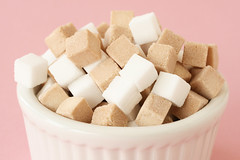(This article is Part II of my carbohydrate addiction series. In order to fully understand it, you should start with Part I, “Why You’re Addicted To Bread“, because it describes the mechanisms of sugar (‘carbohydrate’) addiction—all of which apply equally to breakfast cereal. Part III is here.)
Breakfast Cereal = Skittles
We already know that the glycemic index of both whole wheat and white bread (71-72) equals that of Skittles (70)…but the glycemic index of most breakfast cereals exceeds it. You get the same sugar rush from ‘healthy’, ‘whole grain’ breakfast cereals that you get from candy!
(All figures for North American versions when available, as formulations differ between countries. Also note that differences of + or – 5 points most likely aren’t significant, as measurements vary.)
- Rice Chex: 89. Wow.
- Crispix: 87
- Rice Krispies: 82. Snap, crackle, type II diabetes.
- Corn Flakes: 81. But where are the Frosted Flakes? You’ll be surprised.
- Grapenuts Flakes: 80
- Total: 76. It’s a Total sugar rush!
- Shredded Wheat: 75
- Cheerios: 74. Is that really ‘heart-healthy’?
- Bran Flakes: 74. What about those ‘complex carbohydrates’ that are supposed to digest more slowly? My next article will cover this issue.
- Instant Cream of Wheat: 74
- Weetabix: 74
- Grapenuts: 71
- Skittles: 70. Skittles win again!
- Special K: 69
- Froot Loops: 69.
- Pure white table sugar: 68. No, this isn’t a misprint.
- Instant oatmeal: 66
- Cream of Wheat: 66. Still basically the same as table sugar.
- Raisin Bran: 61
- Oatmeal: 58
- Snickers bar: 55
- Frosted Flakes: 55. No, this isn’t a misprint.
(Figures from here, here, and here.)
Yes, ‘healthy’ cereals like Bran Flakes and Grape Nuts spike your blood sugar more quickly than pure white table sugar, and provide a bigger sugar rush. So by dumping sugar on cold cereal, you’re actually decreasing its glycemic index…and Frosted Flakes has the same glycemic index as ‘healthy’ oatmeal!
Would you eat Skittles for breakfast? No? Then why are you eating cold cereal?
Would you eat a Snickers bar for breakfast? No? Then why are you eating oatmeal?
Cereal: Adjacent To This Complete Breakfast!
Yes, cereal has vitamins and minerals, because it’s ‘fortified’—they’re added after the fact. Just eat Skittles and a multivitamin and you’ll get the same result.
“Robert Choate, an adviser to President Nixon on nutrition, told a congressional hearing into breakfast cereals that the majority “fatten but do little to prevent malnutrition”. Choate was outraged at the aggressive targeting of children in breakfast cereal advertising. He analysed 60 well-known cereal brands and concluded that two-thirds offered “empty calories, a term thus far applied to alcohol and sugar”.
Rats fed a diet of ground-up cereal boxes with sugar, milk and raisins were healthier than rats fed the cereals themselves, he testified to senators.”
–Drop That Spoon, The Guardian, November 23, 2010(Thanks to my friend Bruce for the phrase “Adjacent to this complete breakfast!”)
Cereal: A Triumph Of Marketing
Next time you’re shopping for food, take a moment to notice how expensive cereal is. It’s a triumph of marketing: take wheat or corn that sells for a few dollars a bushel, extrude it into small, crunchy pieces, and sell it for several dollars a pound. I can buy two dozen eggs—or a pound of hamburger, an onion, and a head of garlic—for less than a large box of cereal.
“One of the biggest costs in cereal manufacture is not the value of the ingredients nor the cost of production, but the marketing. About a quarter of the money you spend on breakfast cereal goes on the cost of persuading you to buy it. That still leaves room for gross profit margins on processed cereals that are 40% to 45%.”
–Drop That Spoon
So how did we get snookered into eating expensive empty calories for breakfast? Answer: cereal was invented by religious fundamentalists to destroy your sex drive and keep children from masturbating. Read the complete article “Drop That Spoon” for an eye-opening history.
What should I eat instead?
Fortunately, this is an easy problem to solve. Instead of cereal, eat a traditional American breakfast of meat and eggs. Even better, have an omelet, with some hash browns if you must.
Or, just eat eggs. No, they’re not bad for you.
And now: SCIENCE! proves what’s obvious to all of us: you’ll feel less hungry, and you’ll eat less for the rest of the day, after eating eggs for breakfast.
Ratliff et. al. Consuming eggs for breakfast influences plasma glucose and ghrelin, while reducing energy intake during the next 24 hours in adult men. Nutr Res Vol 30, Issue 2, pp. 96-103 (Feb 2010)
“Subjects consumed fewer kilocalories after the EGG breakfast compared with the BAGEL breakfast (P< .01). In addition, subjects consumed more kilocalories in the 24-hour period after the BAGEL compared with the EGG breakfast (P < .05). Based on VAS, subjects were hungrier and less satisfied 3 hours after the BAGEL breakfast compared with the EGG breakfast (P < .01).”
Live in freedom, live in beauty.
JS
Continue to Part III of this series on glycemic index and carbohydrate addiction—”Fat and Glycemic Index: The Myth Of “Complex Carbohydrates”. (Part I is here.)



